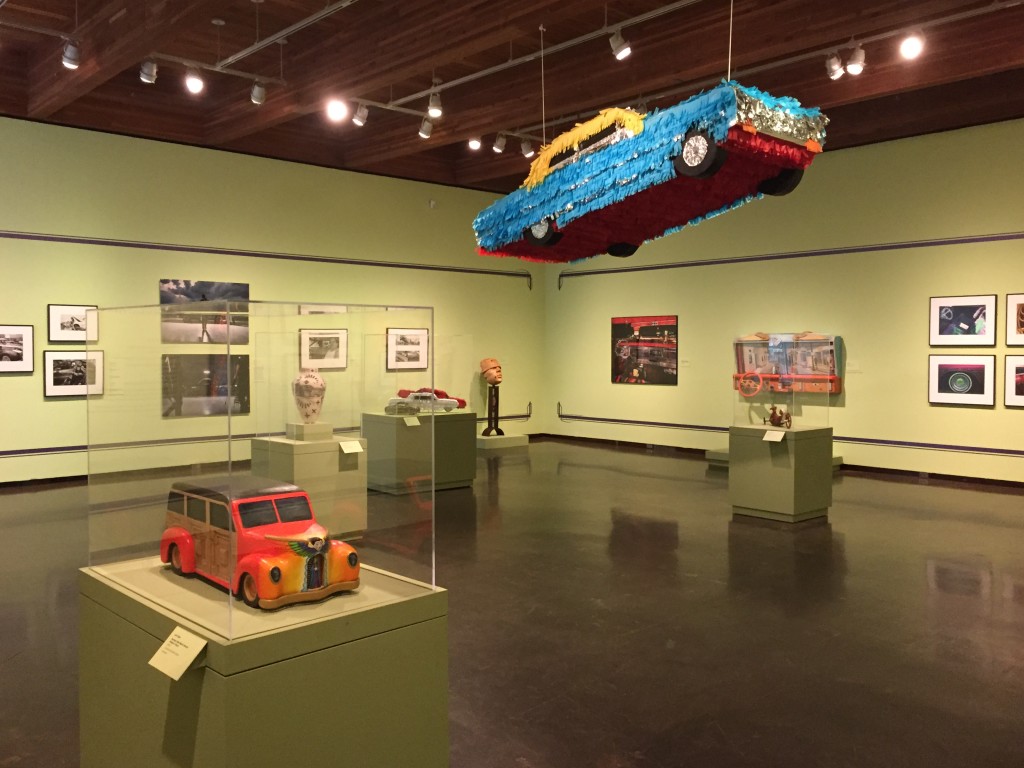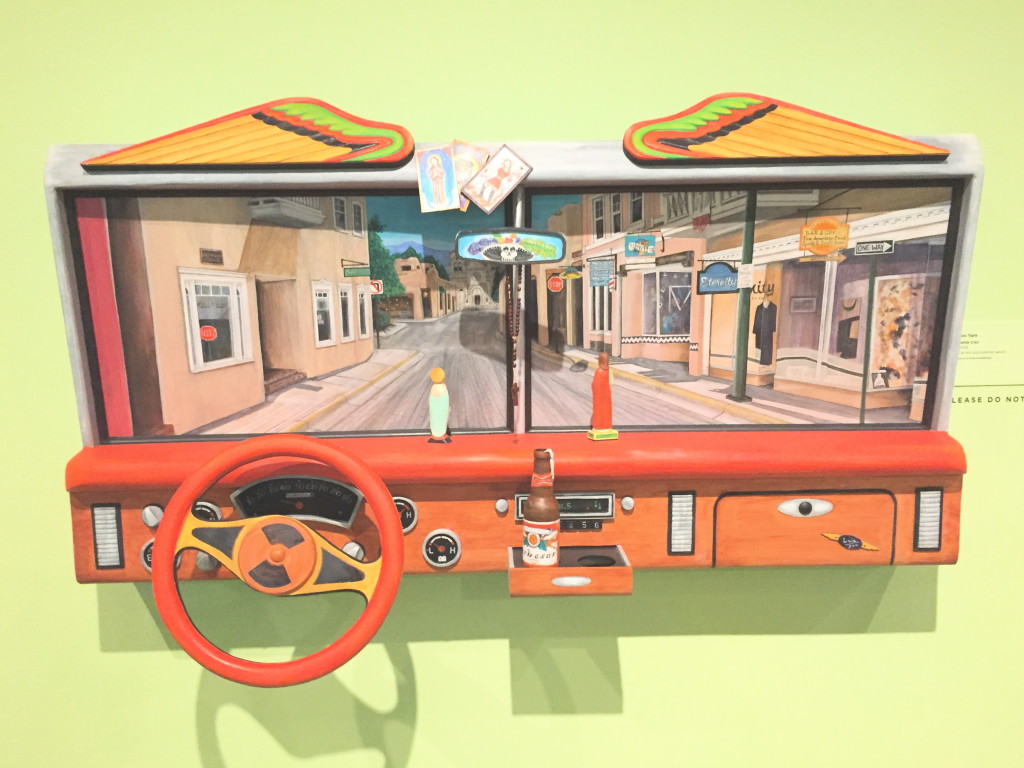Two exhibits bring the world of the lowrider alive at the New Mexico History Museum and the New Mexico Museum of Art in Santa Fe

Photos by Frank X. Moraga / Amigos805 ©2016 A classic lowrider is painted, above, in a variety of colors as part of the exhibit “Lowriders, Hoppers & Hot Rods: Car Culture in Northern New Mexico,” through March 5, 2017 at the New Mexico History Museum.
By Frank X. Moraga / Amigos805
So here I am, walking through a pair of museums in Santa Fe, New Mexico that were exhibiting all things lowrider and wondering what metaphoric road led me here.
There was always something going in our little white garage facing the alley on the south side of Wooley Road in Oxnard.
The quiet of the neighborhood was often shattered with the banging out of a car fender, the grinding and sanding of a door, the masking of the chrome and windows and the overpowering aroma of grey or brown primer or the final coats of lacquer.
 Yes, weekday afternoons or Saturday mornings were not playtime at our home; they were time to work on the ‘55 Chevy, the ‘64 Malibu and numerous other cars and trucks in the Moraga garage.
Yes, weekday afternoons or Saturday mornings were not playtime at our home; they were time to work on the ‘55 Chevy, the ‘64 Malibu and numerous other cars and trucks in the Moraga garage.
Not being overly mechanically inclined, I would have rather been playing basketball or watching TV. But when your older brothers put you to work, there’s not much you can do as a pre-teen but to follow orders.
My brother Jimmy, and later my younger brother Michael, were the body men and painters. Dad had rigged up the garage to become their own little car and body shop, equipped with a noisy compressor outside, air piping on both sides of the garage, plywood walls and an assorted variety of fans that struggled to blow out the paint overspray. My oldest brother Tony was the detail man, meticuliously covering the chrome and windows with masking tape and butcher paper.
 Moi, I was the helper, sweeping the floors, throwing away old tape, paper, pieces of dried bondo, empty paint cans and anything else.
Moi, I was the helper, sweeping the floors, throwing away old tape, paper, pieces of dried bondo, empty paint cans and anything else.
But out of all the banging and madness, the sheer noise, came such beautiful creations — cars painted in a rainbow of colors, metalflake or subtle pearl, pinstripped and detailed, looking showroom fresh when they rolled out of our garage.
Brother Jimmy eventually graduated to painting flames and working on classic motorcycles, while brother Michael turned out beautiful classic lowriders, Impalas, Monte Carlos and occasional oldies like a ‘49 Ford. Many of his works have ended up on the lowrider carshow circuit, with a couple appearing on pages of lowrider magazines.
While I was always the odd one in the family, opting out of the low and slow ride and instead adding wide white-lettered tires, Crager rims and sidepipes to my custom painted Le Mans blue 307 Chevy Nova highrider, I have always been impressed with the quality of work and the quantity of time put in by my brothers and others devotees of the lowrider family as they lovingly worked on their rides for years at a time, chromed everything, added hydraulics and later air bags to make their creations come alive and jump unbelievable heights, or cruise slowly along the boulevard.

“Con Cariño: Artists Inspired by Lowriders” continues through Oct. 10 at the New Mexico Museum of Art. From piñatas to colorful woodcarvings, ceramic pieces, photographs and paintings, the exhibit features all things lowrider.
It was for this love of all things automotive that I decided to take a road trip recently to Santa Fe, to check out the Summer Spanish Market, but to also walk across the Plaza to see two lowrider exhibits at the New Mexico Museum of Art and the New Mexico History Museum.
I headed over to the New Mexico History Museum to view the exhibit “Lowriders, Hoppers & Hot Rods: Car Culture in Northern New Mexico” (through March 5, 2017). Yes, this was a museum and there, sitting in the exhibit hall, were two cherry custom lowriders.
Seeing the lowriders in the exhibit hall, and another located downstairs at one of the entrances, I thought, “Cool, Latino culture has made it to the big time.” First Santa Fe, then lowriders at the Smithsonian. You can always dream
 The cars were surrounded by more than 100 photographs by 31 photographers curated by Daniel Kosharek.
The cars were surrounded by more than 100 photographs by 31 photographers curated by Daniel Kosharek.
“It’s all part of an American love affair with the internal combustion engine and the glimmering accoutrements that these vehicles have inspired through history,” Kosharek was quoted by Kate Nelson of the New Mexico History Museum. Kosharek said his own first car was a 1957 Chevy two-door hardtop in matchstick color—royal blue on the bottom, baby blue on top.
“I’m convinced there are two kinds of people in the world,” Kosharek said. “Those who drive for the purpose of getting from point A to point B, mere transportation if you will; and people like me who drive cars to, well, drive cars. Two types of people, two world views. This exhibit is about the latter: People who express themselves through pride in their ride.”
In addition to the cars and photographs, the exhibit features a chromed and touchable engine, miniature-scale model-car collections, trophies, memorabilia and other ephemera, with the museum lobby hosting a rotating selection of cherry char examples.
After loading up on some great New Mexican food in the plaza, I stepped into the New Mexico Museum of Art to view “Con Cariño: Artists Inspired by Lowriders” (through Oct. 10). I was not sure what to expect as I walked through the galleries of Native American and cowboy-inspired art. But then I walked into the exhibit room and there it was, the first lowrider piñata that I had ever seen.
Then I walked around and was amazed by the variety of inspired art (50), colorful woodcarvings that depicts scenes of a quite pueblo in Northern New Mexico, paintings and large photographs, one that showed what at first appeared to be just a jet black lowrider, until you looked closer and saw it was painted in a shiny black on dull black Santa Clara Pueblo pottery-style design.
“It takes a special vision and a lot of hard work to transform an abandoned car into a one-of-a-kind sculpture on wheels, but that’s exactly what makes New Mexico’s lowriders so special,” the museum reported about the exhibit. “Though they are works of art in their own right, lowriders have also inspired artists working in other mediums. Responding to this unique cultural icon in photographs, paintings, sculptures, and videos, the artists in this exhibition explore issues of family, gender, religion, and status.”
Lowriders tracing their roots (routes)
LOWRIDER: Refers to either a car whose suspension has been lowered to inches from the ground or the person who drives it. In Spanish, it’s bajito y suavecito, or low and slow.
So how did lowriders first spring from the Espanola Valley north of Santa Fe? One story tells of workers in New Mexico heading to Southern California to work in the aircraft factories during World War II. At the same time lowriders were hitting the streets in post-war L.A. in reaction to the Anglo hot rod culture. Some of those New Mexicans returned home, bringing the memory of the lowriders, along with some of the hydraulics from the aircraft factories that would later go into lowriders to give the rides their bounce.
In the 1980s, Española proclaimed itself the Lowrider Capitol of the World and, for years, Riverside Drive has been a place to see the best examples, the museum reported. Today, in communities in Los Angeles, San Antonio, northern New Mexico and elsewhere, car culture thrives.
And as for a lowrider making it to the Smithsonian, well it has actually happened.
In 1992, the Smithsonian Institution put “Dave’s Dream” on permanent exhibition.
The 1969 Ford LTD was started by Dave Jaramillo of Chimayo and was completed by his family and friends after his death in a car accident.
So yes, some lowrider dreams do come true.
Cruising to New Mexico
“Lowriders, Hoppers & Hot Rods: Car Culture in Northern New Mexico,” continues through March 5, 2017 at the New Mexico History Museum, 113 Lincoln Ave., Santa Fe. “Photo Curator Daniel Kosharek has pulled together an extensive collection of images by Don Usner, Annie Sahlin, Jack Parsons, Sam Adams, Norman Mauskopf, Dottie Lopez, Gabriela Campos, Meridel Rubinstein and others,” wrote Kate Nelson. “The museum lobby will host a rotating selection of cherry examples.”
The exhibit “Con Cariño: Artists Inspired by Lowriders,” continues through Oct. 10 at the New Mexico Museum of Art, 107 W. Palace Ave., Santa Fe. More than 50 lowrider-inspired works are on display by such artists as Lawrence Baca & Ron Rodriguez, Justin Favela, Miguel Gandert, Alex Harris, Nicholas Herrera, Arthur Lopez, Norman Mauskopf, El Moisés, Jack Parsons, Meridel Rubenstein, Luis Tapia and Don Usner.
Both museums are located near the historic Santa Fe Plaza.
Reading material
Those interested in all things lowrider can purchase the new photography book “¡Orale! Lowrider: Custom Made in New Mexico” by the Museum of New Mexico Press at: http://mnmpress.org/?p=allBooks&id=241. A panel discussion and book signing on ¡Orale! Lowrider …” will be held Nov. 13 at Collected Works Bookstore in Sante Fe.
Of course there is always the comic book “Lowriders in Space,” Amazon, that I saw at a museum bookstore. Enough said.
